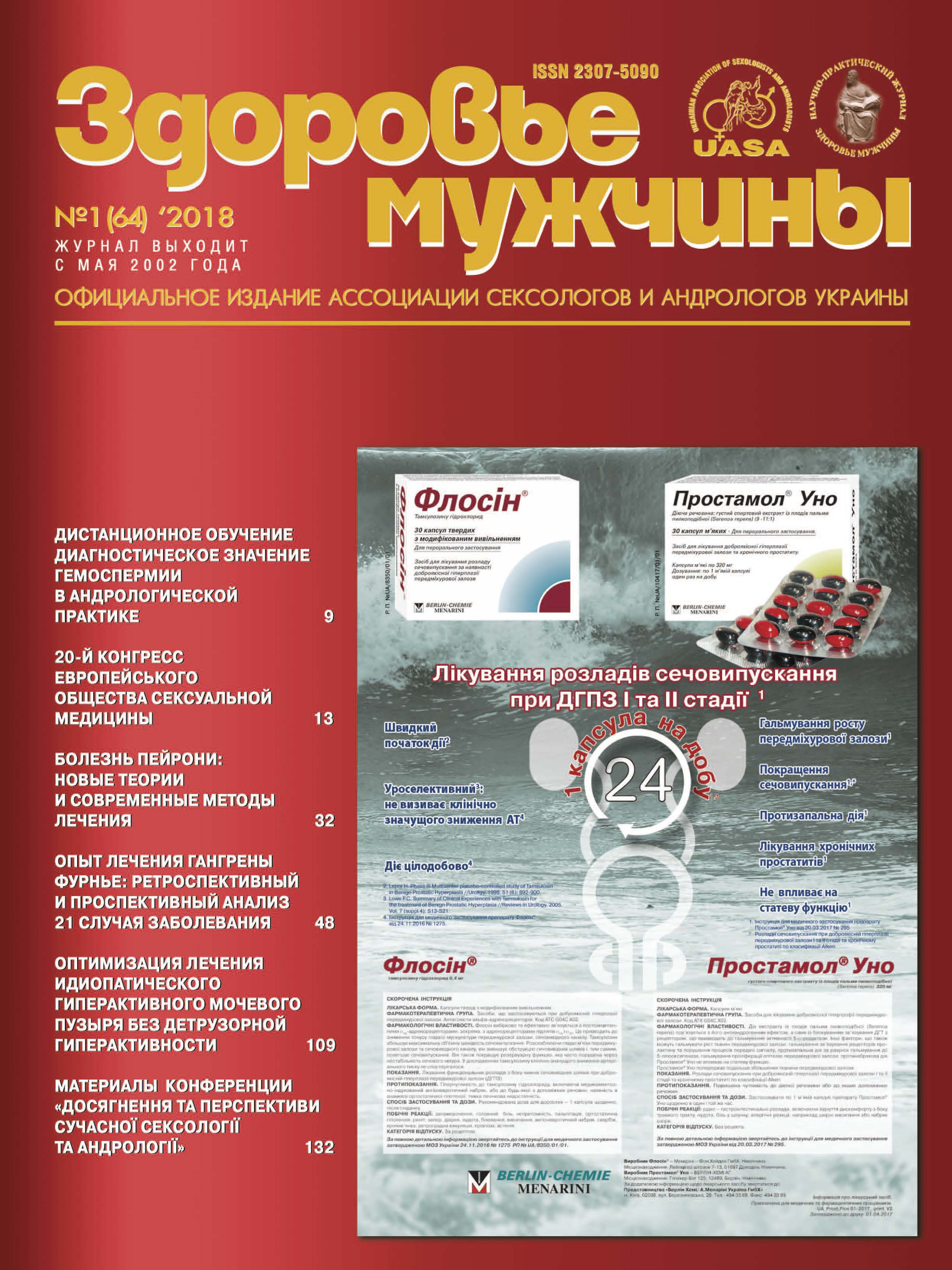Our experience in treatment of Fournier’s gangrene: a retro- and prospective analysis of 21 cases
##plugins.themes.bootstrap3.article.main##
Abstract
The objective: To analyze cases of Fournier’s Gangrene (FG) in urological and surgical departments of the Lviv City Hospital for Emergency Medical Care and Lviv Regional Clinical Hospital; to discuss the main principles of diagnostics and treatment of FG.
Materials and methods. Retrospective and prospective analysis of 21 cases of FG in urological and surgical departments of the Lviv City Hospital for Emergency Medical Care and Lviv Regional Clinical Hospital. Patients were assessed considering their objective status, laboratory results (hematology, urinalysis, blood chemistry, coagulation panel), ultrasound of the perineal area, and in some cases X-ray and CT. All patients received extensive debridement of necrotic tissues within the first few hours since admission. In the post-operative period, subsequent necrectomies with excision of new lesions of necrosis were performed. Patients also received massive antibacterial treatment. In some cases, progression of the pathological process required subsequent extensive tissue debridements.
Results. All 21 patients were urgently admitted to urological or surgical departments. 18 patients (85,7%) were male, 3 patients (14,3%) were female. 9 patients (42,9%) were admitted within the first 6 hours of the disease development, 7 patients (33,3%) were admitted in the 6-8 hour period and 5 patients (23,8%) were admitted within more than 24 hours of the disease development. In 7 cases (33,3%), the lesion was localized and did not extend beyond the scrotum area; in 5 cases (23,8%), the necrotic process had spread to the penis and perineal cellular tissue; in 5 more cases (23,8%), the process had spread to the anterior abdominal wall; and in 4 cases (14%), the process had spread to the interior surface of the thigh. X-ray examination was performed on 6 patients (28,6%) with necrosis spreading to the anterior abdominal wall. Pelvic ultrasound was performed on 11 patients (52,4%) and a CT was performed on 4 patients (14%) – gas within the anterior abdominal wall and/or perineal tissues was detected in all cases. General mortality was 23,8%. 3 patients (14,3%) died within the first 24 hours since surgery, 2 patients (9,6%) died on the second day after surgery. Scrotum-forming surgery (by B. Vicin method) was performed on 17 patients (81%). One patient (4,8%) refused scrotum-forming surgery; during a 3-month follow-up visit, a formed ‘sack’ of granulation tissue was noted, that covered the testicles.
Conclusions. 1. Fournier’s Gangrene is a rare dangerous disease that usually has a fulminant course and requires immediate surgical treatment combined with massive broad-spectrum antibacterial therapy. 2. The mortality rate is proportionate to lesion size, timely admission, and volume of surgical treatment, which should be performed according to criteria, defined in this paper. 3. Surgery must always be radical; nevertheless, the disease’s pathogenesis may necessitate subsequent surgical procedures. Post-operative mortality is caused by sever endogenic intoxication and development of such complications as infectious-toxic shock and multi-organ failure. 4. Performing subsequent necrectomies under general anesthesia (in order to adequately debride necrotized tissue) is necessitated by the disease’s pathogenesis. Active hemorrhage during said debridement is a sign of healthy tissue and should serve as a demarcation line for performing the necrectomy. 5. Scrotum-forming surgery can be performed if needed, but spontaneous wound healing is possible.##plugins.themes.bootstrap3.article.details##

This work is licensed under a Creative Commons Attribution 4.0 International License.
Authors retain the copyright and grant the journal the first publication of original scientific articles under the Creative Commons Attribution 4.0 International License, which allows others to distribute work with acknowledgment of authorship and first publication in this journal.
References
Андрющенко В.П. Гангрена Фурн’є – некротизуючий фасціїт ділянки промежини: сучасні погляди щодо клініки, діагностики, лікування. / Андрющенко В.П., Мельников В.А., Лесняк М.О. // Клінічна хірургія. – 2015. – № 3. – С. 72–76.
Ayan F. Fournier’s Gangrene: a retrospective clinical study of fortyone patients. / Ayan F., Sunamak O., Paksoy S., et al. // ANZ J Surg. – 2005. – № 75. – Р. 1055–1058. https://doi.org/10.1111/j.1445-2197.2005.03609.x
Benjelloun el B. Fournier’s gangrene: our experience with 50 patients and analysis of factors affecting mortality. / Benjelloun el B, Souiki T, Yakla N, et al. // World J Emerg Surg. – 2013 – V. 1. – P. 8–13. https://doi.org/10.1186/1749-7922-8-13
Laor E. Outcome prediction in patients with Fournier’s gangrene. / E. Laor, L.S. Palmer, B.M. Tolia, et al. // J Urol. – 1995. – V. 154 (1). – P. 89–92. http://dx.doi.org/10.1097/00005392-199507000-00032
Ulug M. The evaluation of microbiology and Fournier’s gangrene severity index in 27 patients. / Ulug M, Gedik E, Girgin S, Celen MK, Ayaz C. // Int J Infect Dis. – 2009. – № 13 (6). – Р. 424–430. https://doi.org/10.1016/j.ijid.2009.01.021





